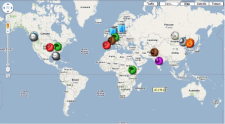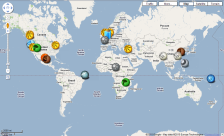 Download files of the story:
Download files of the story:

The Human Factor
Susanne Martin
Sometimes (increasingly, more often than not, I suspect), things do improve for the better, and previously underpriviledged people make a move to improve their lot. This has been happening throughout history, and—as progress accelerates—will continue to happen for the foreseeable future. Slavery has been abolished, women and people of colour have the right to vote and much more. Yes, there are still many racial and other prejudice issues, but we have come a long way, and should get much further.
Also, there seems to be some, let’s call it resistance or reluctance, in letting people in the third world get access to modern technologies. As Nick Mamatas wrote in his SHINE review on SciFi Wire (commenting on Paula R. Stiles’s “Sustainable Development”):
“[…]especially given the social dislocations that often accompany sudden technological changes. (A quick Google of “Yir Yiront” and “stone ax” would have helped.)”
I fully agree that bringing isolated people into contact with modern technology will be highly disturbing for their culture. However, the utmost majority of third world cultures aren’t isolated anymore: this may or may not be a good thing, but it is an inescapable fact. And these non-isolated cultures can and will use modern technologies, to wit:
And many more. Thinking that modern technologies will either disrupt, or are too complicated for the utmost majority of the developing countries is paternalistic at best and oppressive (‘gotta keep these people in their place’) at worst.
Then there is the ‘Girl Effect’: the empowerment of women worldwide. This is already happening through—what some may find counterintuitive—market forces: when I attended a Triodos Bank presentation, I found out that over 90% of the people that received microcredits are women: because they spend the money wisely (don’t squander it on booze and gambling like most of the men).
Now, what would happen if this trend does indeed continue, and develops to its logical conclusion? Susanne Martin portrays a witty ‘what if’, taking “The Human Factor” into account…

Su Lin emerged from her morning mindfulness practice with a smile on her face. She prepared a pot of Jasmine tea taking care to steep it for just the right time, and activated the work terminal by quoting her favourite line of poetry. The moment she faced the screen, she was assaulted by a stream of data that — though noiseless — shattered the serenity of the morning. Su Lin identified the data as results of job applications at SunTech, the firm she worked for. It wasn’t usually her task to review evaluation data; she was one of SunTech’s senior programmers and specialized in algorithms that translated real life data into meaningful numeric correlations. The only reason for the company to feed the read-out to her screen would be a malfunction of ApSel, the program that generated the data, the program Su Lin had designed. She immediately initiated numerous tests and examined the outcomes. She didn’t detect so much as a glitch, let alone a malfunction. With relief and satisfaction, Su Lin picked up her cup of tea.
An unobtrusive chime signaled an incoming call and Peggy Mei’s image filled the screen. Su Lin greeted her superior with a polite bow that went unnoticed as Peggy Mei had started to talk immediately.
“Su Lin,” she said, “I need you to look at the data. SunTech has placed absolute trust in your program. We have, as you’re well aware, eliminated all other selection methods. And this has put us in a difficult situation.” Continue reading →






















